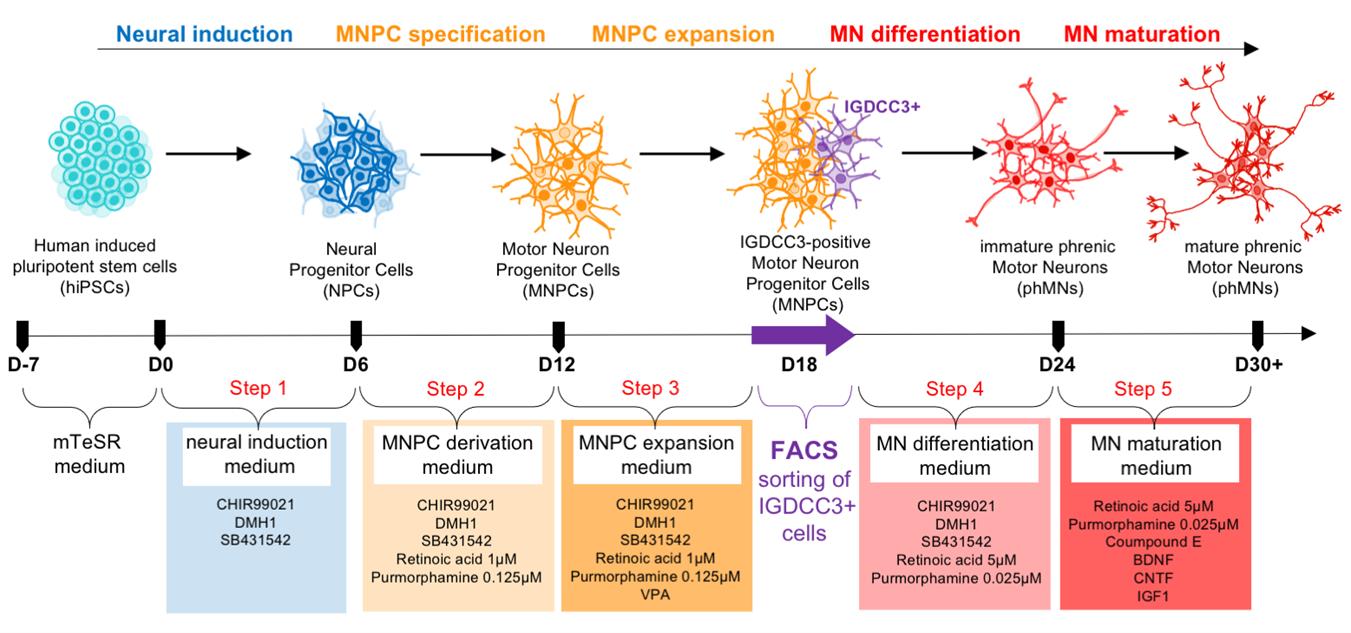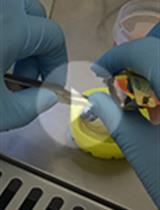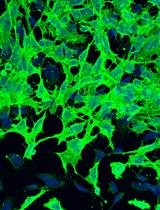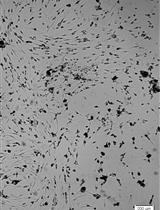- EN - English
- CN - 中文
Derivation and Culture of Enriched Phrenic-Like Motor Neurons From Human iPSCs
人源iPSC来源的富集膈神经样运动神经元的诱导与培养
发布: 2025年07月05日第15卷第13期 DOI: 10.21769/BioProtoc.5363 浏览次数: 2202
评审: Philipp WörsdörferAnonymous reviewer(s)
Abstract
The fatal motor neuron (MN) disease amyotrophic lateral sclerosis (ALS) is characterized by progressive degeneration of the phrenic MNs (phMNs) controlling the activity of the diaphragm, leading to death by respiratory failure. Human experimental models to study phMNs are lacking, hindering the understanding of the mechanisms of phMN degeneration in ALS. Here, we describe a protocol to derive phrenic-like MNs from human induced pluripotent stem cells (hiPSC-phMNs) within 30 days. During spinal cord development, phMNs emerge from specific MN progenitors located in the dorsalmost MN progenitor (pMN) domain at cervical levels, under the control of a ventral-to-dorsal gradient of Sonic hedgehog (SHH) signaling and a rostro-caudal gradient of retinoic acid (RA). The method presented here uses optimized concentrations of RA and the SHH agonist purmorphamine, followed by fluorescence-activated cell sorting (FACS) of the resulting MN progenitor cells (MNPCs) based on a cell-surface protein (IGDCC3) enriched in hiPSC-phMNs. The resulting cultures are highly enriched in MNs expressing typical phMN markers. This protocol enables the generation of hiPSC-phMNs and is highly reproducible using several hiPSC lines, offering a disease-relevant system to study mechanisms of respiratory MN dysfunction. While the protocol has been validated in the context of ALS research, it can be adopted to study human phrenic MNs in other research fields where these neurons are of interest.
Key features
• This protocol generates enriched hiPSC-derived phrenic motor neuron cultures.
• The protocol can be used to develop models to study human respiratory motor neuron disease.
• The protocol allows the generation of phrenic motor neuron preparations with potential for motor neuron replacement strategies.
• The protocol requires experience in hiPSC culturing and FACS-based cell sorting for a successful outcome.
Keywords: Phrenic motor neurons (膈神经运动神经元)Graphical overview

Representation of the experimental design to generate human induced pluripotent stem cell (hiPSC)-derived cultures enriched in phrenic motor neurons using the indicated combination of small molecules and FACS-based cell sorting.
Background
Respiratory failure is the primary cause of death in amyotrophic lateral sclerosis (ALS) patients [1,2] and is mainly the result of the degeneration of phrenic motor neurons (phMNs) that control the major inspiratory muscle, the diaphragm [3]. Compared to other spinal MNs, phMNs present distinct developmental origin, topology, and electrophysiological properties [4–7]. In ALS animal models, phMN progressive loss begins before symptom onset [8] and is more pronounced than other spinal respiratory MNs [9,10], suggesting selective cell death mechanisms among different MN subtypes [3,11–14]. Consequently, model systems based on other MN subtypes cannot account for the specialized biology of phMNs and their vulnerability to degeneration in ALS. The study of motor neuron pathophysiology in ALS and other MN diseases has been significantly facilitated by the advent of hiPSC-based approaches, enabling robust and reliable generation of human MNs. To date, the best-characterized and most commonly used hiPSC-based MN derivation protocols generate heterogeneous cultures containing mainly MNs of the lateral (LMC) and median (MMC) motor columns [15–19], with only 10% of MNs expressing the phMN marker gene, SCIP [20]. The intrinsic heterogeneity of currently available hiPSC-derived MN preparations and the scarcity of phMNs in these cultures make them inadequate to study phMN pathophysiology, including mechanisms of phMN degeneration in ALS or other respiratory MN diseases. We therefore sought to develop methods to generate phMN-enriched cultures from hiPSCs.
Materials and reagents
Biological materials
1. Human induced pluripotent cell (iPSC) line NCRM-1 (National Institutes of Health Stem Cell Resource, Bethesda, MD, USA, identification number: ND50028)
2. Human iPSC line CS29iALS-C9nxx (hereafter CS29-ALS for brevity) and corrected human iPSC line CS29iALS-C9n1.ISOnxx (CS29 isogenic) (Cedars-Sinai, Los Angeles, CA, USA, identification number: CVCL_W559)
3. Human iPSC line CS52iALS-C9nxx (CS52-ALS) and corrected human iPSC line CS52iALS-C9n6.ISOnxx (CS52 isogenic) (Cedars-Sinai, Los Angeles, CA, USA, identification number: CVCL_JC27)
Reagents
1. mTeSR1 medium (400 mL mTeSR1 basal medium bottle + mTeSR1 5× supplement to combine before use) (STEMCELL Technologies, catalog number: 85850)
2. CorningTM MatrigelTM hESC-qualified matrix (Fisher Scientific, catalog number: 08-774-552)
3. Gentle cell dissociation reagent (STEMCELL Technologies, catalog number: 07174)
4. Poly-L-ornithine hydrobromide (PLO) (Sigma-Aldrich, catalog number: P3655)
5. Mouse laminin (Sigma-Aldrich, catalog number: L2020)
6. DMEM/F12 (Thermo Fisher Scientific, catalog number: 11320033)
7. GlutaMAX (Thermo Fisher Scientific, catalog number: 35050-061)
8. Neurobasal medium (Thermo Fisher Scientific, catalog number: 21103-049)
9. N2 supplement 100× (Thermo Fisher Scientific, catalog number: 17502-048)
10. B27 supplement 50×, serum free (Thermo Fisher Scientific, catalog number: 1704-044)
11. L-Ascorbic acid (Sigma-Aldrich, catalog number: A5960)
12. Antibiotic–antimycotic 100× (Thermo Fisher Scientific, catalog number: 15240-062)
13. CHIR99021 (STEMCELL Technologies, catalog number: 72054)
14. DMH1 (Sigma-Aldrich, catalog number: D8946)
15. SB431542 (Tocris Bioscience, catalog number: 1614)
16. Retinoic acid (RA) (Sigma-Aldrich, catalog number: R2625)
17. Purmorphamine (Sigma-Aldrich, catalog number: SML-0868)
18. Valproic acid sodium salt (VPA) (Sigma-Aldrich, catalog number: P4543)
19. Compound E (Calbiochem, catalog number: 565790)
20. Recombinant human insulin-like growth factor 1 (IGF-1) (R&D Systems, catalog number: 291-G1-200)
21. Human brain–derived neurotrophic factor recombinant protein (BDNF) (Thermo Fisher Scientific, catalog number: PHC7074)
22. Recombinant human ciliary neurotrophic factor (CNTF) (R&D Systems, catalog number: 257-NT-050)
23. Dendritic polyglycerol amine (dPGA) (kindly provided by Dr. T. E. Kennedy, MNI, McGill University, Montreal, Canada)
24. ROCK inhibitor (Y-27632 2HCl) (Tocris Bioscience, catalog number: 1254)
25. Trypan blue solution, 0.4% (Thermo Fisher Scientific, Gibco, catalog number: 15250061)
26. Paraformaldehyde (PFA) (EMD, Sigma Millipore, catalog number: 8187150100)
27. Glycerol, 99+%, extra pure (Thermo Scientific Chemicals, Fisher Scientific, catalog number: AC158920025)
28. Normal donkey serum (NDS) (Jackson ImmunoResearch, catalog number: 017-000-121)
29. Normal goat serum (NGS) (Jackson ImmunoResearch, catalog number: 005-000-121)
30. BSA (Sigma Millipore, catalog number: A7906)
31. Triton, 100× (Sigma Millipore, catalog number: T8787)
32. Goat anti-SRY-BOX 1 (SOX1), 1/500 (R&D Systems, catalog number: AF3369)
33. Rabbit anti-HOMEOBOX C4 (HOXC4), 1/150; kindly provided by Dr. Jeremy Dasen, New York University School of Medicine, New York, NY)
34. Rabbit anti-PAX6, 1/500 (Covance, catalog number: PRB-278P, can now be found on the BioLegend website, under the catalog number 901302)
35. Mouse anti-PAX6 clone AD1.5, 1/150 (Sigma Millipore Corp., catalog number: MAB5554)
36. Rat panTLE monoclonal antibody supernatant, 1/10 (originally developed by Stifani and colleagues21)
37. Mouse anti-OLIG2, 1/100 (Sigma Millipore Corp., catalog number: MABN50)
38. Goat anti-OLIG2, 1/200 (R&D Systems, catalog number: AF2418)
39. Rabbit anti-LIMB HOMEOBOX CONTAINING 3 (LHX3), 1/100 (Abcam, catalog number: ab14555, now discontinued)
40. Rabbit anti-FORKHEAD BOX PROTEIN 1 (FOXP1), 1/350 (Abcam, catalog number: ab16645)
41. Rabbit anti-HOMEOBOX A5 (HOXA5), 1/150 (kindly provided by Dr. Jeremy Dasen, New York University School of Medicine, New York, NY)
42. Mouse anti-HOMEOBOX PROTEIN HB9 (HB9), 1/30 (DSHB, catalog number: 81.5C10-c)
43. Mouse anti-ISLET1 (ISL1), 1/30 (DSHB, catalog number: 39.4D5-c)
44. Guinea pig anti-SCIP, 1/16,000 (kindly provided by Dr. Jeremy Dasen, New York University School of Medicine, New York, NY)
45. Goat anti-ChAT, 1/100 (Sigma Millipore, catalog number: AB144P)
46. Chicken anti-ChAT, 1/1000 (Aves Labs, catalog number: CAT)
47. Donkey anti-goat secondary antibody Alexa FluorTM 488, 1/1,000 (Thermo Fisher Scientific, Invitrogen, catalog number: A-11055)
48. Donkey anti-rabbit secondary antibody Alexa FluorTM 647, 1/1,000 (Thermo Fisher Scientific, Invitrogen, catalog number: A-31573)
49. Donkey anti-mouse secondary antibody Alexa FluorTM 555, 1/1,000 (Thermo Fisher Scientific, Invitrogen, catalog number: A-31570)
50. Donkey anti-rat secondary antibody Alexa FluorTM 488, 1/1,000 (Thermo Fisher Scientific, Invitrogen, catalog number: A-21208)
51. Goat anti-mouse secondary antibody Alexa FluorTM 647, 1/1,000 (Thermo Fisher Scientific, Invitrogen, catalog number: A-21235)
52. Goat anti-rabbit secondary antibody Alexa FluorTM 488, 1/1,000 (Thermo Fisher Scientific, Invitrogen, catalog number: A-11008)
53. Goat anti-guinea pig secondary antibody Alexa FluorTM 555, 1/1,000 (Thermo Fisher Scientific, Invitrogen, catalog number: A-21435)
54. Goat anti-chicken secondary antibody Alexa FluorTM 647, 1/1,000 (Thermo Fisher Scientific, Invitrogen, catalog number: A-21449)
55. Fluoromount G® mounting medium (Southern Biotech. catalog number: 0100-01)
56. Hoechst 33258 solution (Millipore Sigma, catalog number: 94403)
57. Dulbecco’s PBS, no calcium, no magnesium (D-PBS) (Thermo Fisher Scientific, catalog number: 14190144)
58. Live/DeadTM Fixable Aqua (Thermo Fisher Scientific, catalog number: L34957)
59. Fetal bovine serum, qualified, heat-inactivated (FBS) (Gibco, catalog number: 12484-028)
60. Sodium azide (NaN3) (Millipore Sigma, catalog number: S2002-5G)
61. Alexa Fluor® 647-conjugated human IGDCC3 extracellular antibody, 1:20 (R&D Systems, catalog number: FAB8559R)
62. SpectraComp® Unmixing Controls beads (Slingshot Bio, catalog number: SSB-05-B)
63. ViaComp® beads (Slingshot Bio, catalog number: SSB-07-A)
Solutions
1. Poly-L-ornithine stock solution (see Recipes)
2. Laminin stock solution (see Recipes)
3. Matrigel stock solution (see Recipes)
4. Rock inhibitor stock solution (see Recipes)
5. CHIR99021 stock solution (see Recipes)
6. DMH1 stock solution (see Recipes)
7. SB431542 stock solution (see Recipes)
8. Ascorbic acid stock solution (see Recipes)
9. Purmorphamine stock solution (see Recipes)
10. Retinoic acid stock solution (see Recipes)
11. Valproic acid stock solution (see Recipes)
12. Compound E stock solution (see Recipes)
13. BDNF stock solution (see Recipes)
14. CNTF stock solution (see Recipes)
15. IGF-1 stock solution (see Recipes)
16. Neural induction medium (Step 1) (see Recipes)
17. Motor neuron progenitor cell derivation medium (Step 2) (see Recipes)
18. Motor neuron progenitor cell expansion medium (Step 3) (see Recipes)
19. Motor neuron differentiation medium (Step 4) (see Recipes)
20. Motor neuron maturation medium (Step 5) (see Recipes)
21. FACS buffer (see Recipes)
22. Blocking solution (see Recipes)
Recipes
1. Poly-L-ornithine stock solution
| Reagent | Stock concentration | Quantity or Volume |
|---|---|---|
| Poly-L-ornithine (PLO) | 1 mg/mL | 100 mg |
| PBS | n/a | 100 mL |
Dissolve PLO in PBS, aliquot, and store at -80 °C as a stock solution.
2. Laminin stock solution
| Reagent | Stock concentration | Quantity or Volume |
|---|---|---|
| Laminin | 1 mg/mL | 100 μL |
| DMEM/F12 | n/a | 20 mL |
Prepare 100 μL aliquots of laminin to be stored at -80 °C. For use, dilute 100 μL of Laminin into 20 mL of DMEM/F12 media to a final concentration of 5 µg/mL and store at -20 °C (see step B1c). Once thawed on ice, diluted laminin can be stored at 4 °C, in the dark, for 1–2 weeks.
3. Matrigel stock solution
Prepare 100 μL aliquots of Matrigel in microtubes covered with aluminum foil (to hide from light, see General note 6) and store at -80 °C as a stock solution. For use, thaw aliquoted Matrigel on ice 1 h before adding it to cold DMEM/F12 at a final concentration of 1/100 (see step A1a–b). Freeze-thaw cycles should be minimized by aliquoting into one-time-use aliquots.
4. Rock inhibitor stock solution
| Reagent | Stock concentration | Quantity or Volume |
|---|---|---|
| Rock inhibitor | 10 mM | 50 mg |
| DMSO | n/a | 15.612 mL |
Dissolve Rock inhibitor in DMSO, aliquot, and store at -80 °C as a stock solution. Once thawed, Rock inhibitor aliquots can be kept for 1–4 weeks at 4 °C. Rock inhibitor is used at a final concentration of 10 μM.
5. CHIR99021 stock solution
| Reagent | Stock concentration | Quantity or Volume |
|---|---|---|
| CHIR99021 | 3 mM | 10 mg |
| DMSO | n/a | 7.168 mL |
Dissolve CHIR99021 in DMSO, aliquot, and store at -80 °C as a stock solution.
6. DMH1 stock solution
| Reagent | Stock concentration | Quantity or Volume |
|---|---|---|
| DMH1 | 4 mM | 5 mg |
| DMSO | n/a | 3.2856 mL |
Dissolve DMH1 in DMSO, aliquot, and store at -80 °C as a stock solution.
7. SB431542 stock solution
| Reagent | Stock concentration | Quantity or Volume |
|---|---|---|
| SB431542 | 10 mM | 10 mg |
| DMSO | n/a | 2.604 mL |
Dissolve SB431542 in DMSO, aliquot, and store at -80 °C as a stock solution.
8. Ascorbic acid stock solution
| Reagent | Stock concentration | Quantity or Volume |
|---|---|---|
| Ascorbic acid | 200 mM | 176.12 mg |
| H2O | n/a | 5 mL |
Dissolve ascorbic acid in H2O, aliquot in microtubes covered with aluminum foil (to hide from light), and store at -80 °C as a stock solution.
9. Purmorphamine stock solution
| Reagent | Stock concentration | Quantity or Volume |
|---|---|---|
| Purmorphamine | 2 mM | 5 mg |
| DMSO | n/a | 4.802 mL |
Dissolve purmorphamine in DMSO, aliquot, and store at -80 °C as a stock solution.
10. Retinoic acid stock solution
| Reagent | Stock concentration | Quantity or Volume |
|---|---|---|
| Retinoic acid | 10 mM | 30 mg |
| DMSO | n/a | 10 mL |
Dissolve retinoic acid in DMSO, aliquot in microtubes covered with aluminum foil (to hide from light, see General note 4), and store at -80 °C as a stock solution.
11. Valproic acid stock solution
| Reagent | Stock concentration | Quantity or Volume |
|---|---|---|
| Valproic acid | 0.5 M | 831 mg |
| H2O | n/a | 10 mL |
Dissolve valproic acid in H2O, aliquot, and store at -80 °C as a stock solution.
12. Compound E stock solution
| Reagent | Stock concentration | Quantity or Volume |
|---|---|---|
| Compound E | 0.1 mM | 1 mg |
| DMSO | n/a | 20.388 mL |
Dissolve compound E in DMSO, aliquot, and store at -80 °C as stock solution.
13. BDNF stock solution
| Reagent | Stock concentration | Quantity or Volume |
|---|---|---|
| BDNF | 10 µg/mL | 10 µg |
| Distilled water | n/a | 1 mL |
Dissolve BDNF in distilled water, aliquot, and store at -80 °C as a stock solution.
14. CNTF stock solution
| Reagent | Stock concentration | Quantity or Volume |
|---|---|---|
| CNTF | 10 µg/mL | 10 µg |
| Distilled water | n/a | 1 mL |
Dissolve CNTF in distilled water, aliquot, and store at -80 °C as a stock solution.
15. IGF-1 stock solution
| Reagent | Stock concentration | Quantity or Volume |
|---|---|---|
| IGF-1 | 10 µg/mL | 10 µg |
| Distilled water | n/a | 1 mL |
Dissolve IGF-1 in distilled water, aliquot, and store at -80 °C as stock solution.
16. Neural induction medium (Step 1)
| Reagent | Final concentration | Quantity or Volume |
|---|---|---|
| DMEM/F12 | n/a | 14.4 mL |
| Neurobasal medium | 1/1 | 14.4 mL |
| N2 (200×) | 0.5× | 150 μL |
| B27 (100×) | 0.5× | 300 μL |
| L-GlutaMAX (200×) | 0.5× | 150 μL |
| Antibiotic-antimycotic (100×) | 1× | 300 μL |
| Ascorbic acid (200 mM) | 100 μM | 15 μL |
| CHIR99021 (3 mM) | 3 μM | 30 μL |
| DMH1 (4 mM) | 2 μM | 15 μL |
| SB (10 mM) | 2 μM | 6 μL |
| Total | n/a | 30 mL |
17. Motor neuron progenitor cell derivation medium (Step 2)
| Reagent (stock concentration) | Final concentration | Quantity or Volume |
|---|---|---|
| DMEM/F12 | n/a | 14.4 mL |
| Neurobasal medium | 1/1 | 14.4 mL |
| N2 (200×) | 0.5× | 150 μL |
| B27 (100×) | 0.5× | 300 μL |
| L-GlutaMAX (200×) | 0.5× | 150 μL |
| Antibiotic-antimycotic (100×) | 1× | 300 μL |
| Ascorbic acid (200 mM) | 100 μM | 15 μL |
| CHIR99021 (3 mM) | 1 μM | 10 μL |
| DMH1 (4 mM) | 2 μM | 15 μL |
| SB (10 mM) | 2 μM | 6 μL |
| Retinoic acid (10 mM) | 1 μM | 3 μL |
| Purmorphamine (2 mM) | 0.125 μM | 1.875 μL |
| Total | n/a | 30 mL |
18. Motor neuron progenitor cell expansion medium (Step 3)
| Reagent (stock concentration) | Final concentration | Quantity or Volume |
|---|---|---|
| DMEM/F12 | n/a | 14.4 mL |
| Neurobasal medium | 1/1 | 14.4 mL |
| N2 (200×) | 0.5× | 150 μL |
| B27 (100×) | 0.5× | 300 μL |
| L-GlutaMAX (200×) | 0.5× | 150 μL |
| Antibiotic-antimycotic (100×) | 1× | 300 μL |
| Ascorbic acid (200 mM) | 100 μM | 15 μL |
| CHIR99021 (3 mM) | 3 μM | 30 μL |
| DMH1 (4 mM) | 2 μM | 15 μL |
| SB (10 mM) | 2 μM | 6 μL |
| Retinoic acid (10 mM) | 1 μM | 3 μL |
| Purmorphamine (2 mM) | 0.125 μM | 1.875 μL |
| Valproic acid (0.5 M) | 500 μM | 30 μL |
| Total | n/a | 30 mL |
19. Motor neuron differentiation medium (Step 4)
| Reagent (stock concentration) | Final concentration | Quantity or Volume |
|---|---|---|
| DMEM/F12 | n/a | 14.4 mL |
| Neurobasal medium | 1/1 | 14.4 mL |
| N2 (200×) | 0.5× | 150 μL |
| B27 (100×) | 0.5× | 300 μL |
| L-GlutaMAX (200×) | 0.5× | 150 μL |
| Antibiotic-antimycotic (100×) | 1× | 300 μL |
| Ascorbic acid (200 mM) | 100 μM | 15 μL |
| CHIR99021 (3 mM) | 3 μM | 30 μL |
| DMH1 (4 mM) | 2 μM | 15 μL |
| SB (10 mM) | 2 μM | 6 μL |
| Retinoic acid (10 mM) | 5 μM | 15 μL |
| Purmorphamine (2 mM) | 0.025 μM | 0.375 μL |
| Total | n/a | 30 mL |
20. Motor neuron maturation medium (Step 5)
| Reagent (stock concentration) | Final concentration | Quantity or Volume |
|---|---|---|
| DMEM/F12 | n/a | 14.4 mL |
| Neurobasal medium | 1/1 | 14.4 mL |
| N2 (200×) | 0.5× | 150 μL |
| B27 (100×) | 0.5× | 300 μL |
| L-GlutaMAX (200×) | 0.5× | 150 μL |
| Antibiotic-antimycotic (100×) | 1× | 300 μL |
| Ascorbic acid (200 mM) | 100 μM | 15 μL |
| Retinoic acid (10 mM) | 5 μM | 15 μL |
| Purmorphamine (2 mM) | 0.025 μM | 0.375 μL |
| Compound E (0.1 mM) | 0.1 μM | 30 μL |
| BDNF (10 µg/mL) | 10 ng/mL | 30 μL |
| CNTF (10 µg/mL) | 10 ng/mL | 30 μL |
| IGF-1 (10 µg/mL) | 10 ng/mL | 30 μL |
| Total | n/a | 30 mL |
21. FACS buffer
| Reagent | Final concentration | Quantity or Volume |
|---|---|---|
| FBS | 5% | 20 mL |
| NaN3 | 0.1% w/v | 2 mL (stock: 20% w/v) |
| D-PBS | n/a | 378 mL |
| Total | n/a | 400 mL |
22. Blocking solution
| Reagent | Final concentration | Quantity or Volume |
|---|---|---|
| NDS or NGS | 5% | 500 μL |
| BSA | 0.6% | 60 μL |
| Triton 100× | 0.5% | 50 μL |
| PBS 1× | n/a | 9.4 mL |
| Total | n/a | 10 mL |
Laboratory supplies
1. 6-cm BioLiteTM cell culture treated dishes (Thermo Fisher Scientific, catalog number: 130181)
2. 25 cm2 BioLiteTM cell culture treated flasks (T25 flasks) (Fisher Scientific, catalog number: 12-556-009)
3. 24-well BioLiteTM microwell plates (Thermo Fisher Scientific, catalog number: 130186)
4.Serological pipettes, disposable, sterile (5 mL) (Thermo Fisher Scientific, catalog number: 170366N)
5. Serological pipettes, disposable, sterile (10 mL) (Thermo Fisher Scientific, catalog number: 170367N)
6. Conical tubes (15 mL) (Thermo Fisher Scientific, catalog number: 339650)
7. Conical tubes (50 mL) (Thermo Fisher Scientific, catalog number: 339652)
8. Coverslips (Thermo Fisher Scientific, catalog number: 12-545-80)
9. Kimtech ScienceTM KimwipesTM delicate task wipes (Kimberly-Clark Professional, catalog number: 34120)
10. MACS® SmartStrainer (30 μm) (Miltenyi Biotec, catalog number: 130-098-458)
11. FisherbrandTM frosted microscope slides (Thermo Fisher Scientific, catalog number: 12-550-343)
12. Falcon® 5 mL round bottom polystyrene test tube (Corning, catalog number: 352008)
Equipment
1. Laboratory centrifuge with rotors for 15 and 50 mL conical tubes (Eppendorf, catalog number: 5702)
2. FisherbrandTM IsotempTM general purpose deluxe water baths (Fisher Scientific, model: Isotemp GPD 05, catalog number: FSGPD05)
3. Inverted phase contrast microscope (Zeiss, model: Axiovert 40C, catalog number: Z-AXIO40C)
4. LUNA-IITM automated cell counter (Logos Biosystems Inc.; model: LUNA-II, catalog number: L40001)
5. FACSAria Fusion (Becton-Dickinson Biosciences, catalog number: 656700G5)
6. BD FACSAriaTM fusion temperature control option (TCO) fusion (Becton-Dickinson Biosciences, catalog number: 643154)
Software and datasets
1. BD FACSDiva Software (Becton-Dickinson Biosciences, Version: 8.0.1)
Procedure
文章信息
稿件历史记录
提交日期: Apr 17, 2025
接收日期: May 26, 2025
在线发布日期: Jun 10, 2025
出版日期: Jul 5, 2025
版权信息
© 2025 The Author(s); This is an open access article under the CC BY-NC license (https://creativecommons.org/licenses/by-nc/4.0/).
如何引用
Thiry, L., Sirois, J., Durcan, T. M. and Stifani, S. (2025). Derivation and Culture of Enriched Phrenic-Like Motor Neurons From Human iPSCs. Bio-protocol 15(13): e5363. DOI: 10.21769/BioProtoc.5363.
分类
神经科学 > 感觉和运动系统 > 细胞分离和培养
干细胞 > 成体干细胞 > 神经干细胞
细胞生物学 > 细胞分离和培养
您对这篇实验方法有问题吗?
在此处发布您的问题,我们将邀请本文作者来回答。同时,我们会将您的问题发布到Bio-protocol Exchange,以便寻求社区成员的帮助。
Share
Bluesky
X
Copy link













